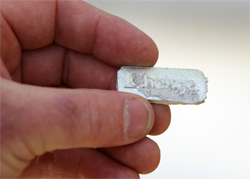Prometheus is more than just the name of a big summer movie opening next week. It’s a furnace – in fact, the first fossil fuel-free furnace of its kind, located at Nova Scotia’s Lunenburg Industrial Foundry & Engineering Limited, established in 1891.
It was a logical choice, then, for Dalhousie’s College of Sustainability to approach the foundry and develop a special keepsake pewter lapel pin for the first class of Environment, Sustainability and Society grads.
The Prometheus furnace, solar-powered, represents a synthesis of sustainable method and local character ideal for marking a Dalhousie ESS graduate.
“One of the unique aspects of Lunenburg Foundry is that it’s located smack-dab in the middle of a UNESCO world heritage site,” says Peter Kinley, the foundry’s president and a graduate of the Nova Scotia Technical College (nowadays Dalhousie’s Sexton Campus).
The Prometheus furnace, he says, was a by-product of the Lunenburg Foundry’s determination to maintain the purity of their picturesque surroundings in their business practices. The furnace “has a huge advantage in the simplicity and cost effectiveness of concentrated solar energy… my son Joseph, who’s an engineer, came up with the project codename. He had studied Greek mythology and felt it was appropriate.”
 There are no shortcuts to quality, as Mr. Kinley demonstrates when he outlines the painstaking step-by-step process of making the pins, which bear the ESS's "Change" motto. (Left: a pin fresh out of the rubber mould.)
There are no shortcuts to quality, as Mr. Kinley demonstrates when he outlines the painstaking step-by-step process of making the pins, which bear the ESS's "Change" motto. (Left: a pin fresh out of the rubber mould.)
“The design was put together,” he says. “The first pattern was developed from a 3D printer at the Sexton Campus. That was used to make a rubber mold… wax positives were then assembled… we dip them in ceramic, then we melted the wax out and poured the solar heated hot metal in. And that gave us the little castings…which were finally mounted on pins,” he concludes. “It’s basically the same product as you would get through using fossil fuels… the main difference is we’re doing this with clean energy and so we’re doing it sustainably.”
The Prometheus furnace isn’t usually used for small jewellery. It more frequently casts the company’s line of brass souvenirs, and the development team is targeting larger commercial pieces such as propellers and machine components – things that “you certainly couldn’t put on your lapel,” Mr. Kinley wisecracks. “You’d be falling over.”
A smaller casting, however, isn’t necessarily simpler. “These happen to be about the smallest metal castings we’ve ever made… the details are very important. We’ve learned a lot of neat tricks as we’ve gone through it.”

